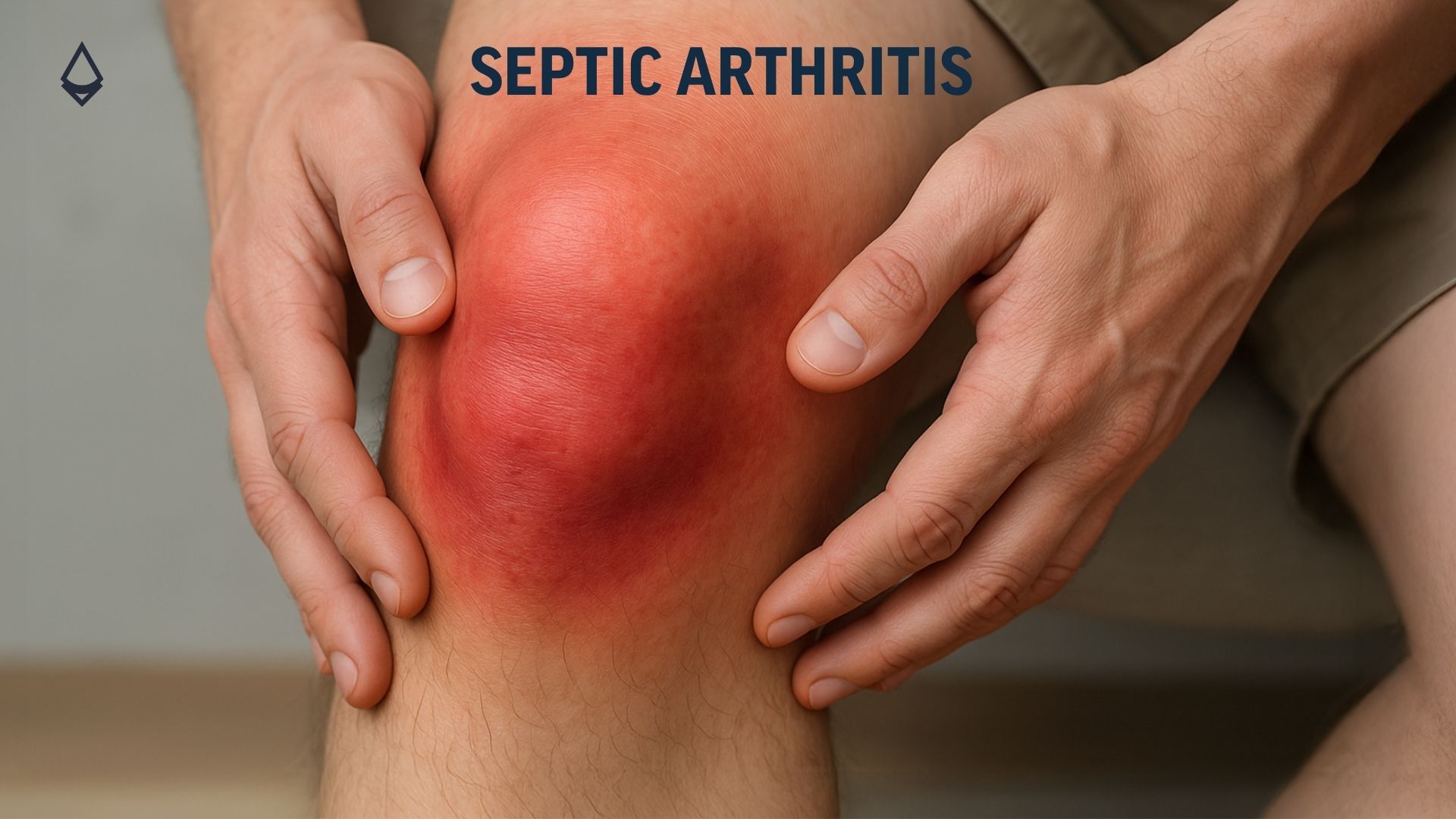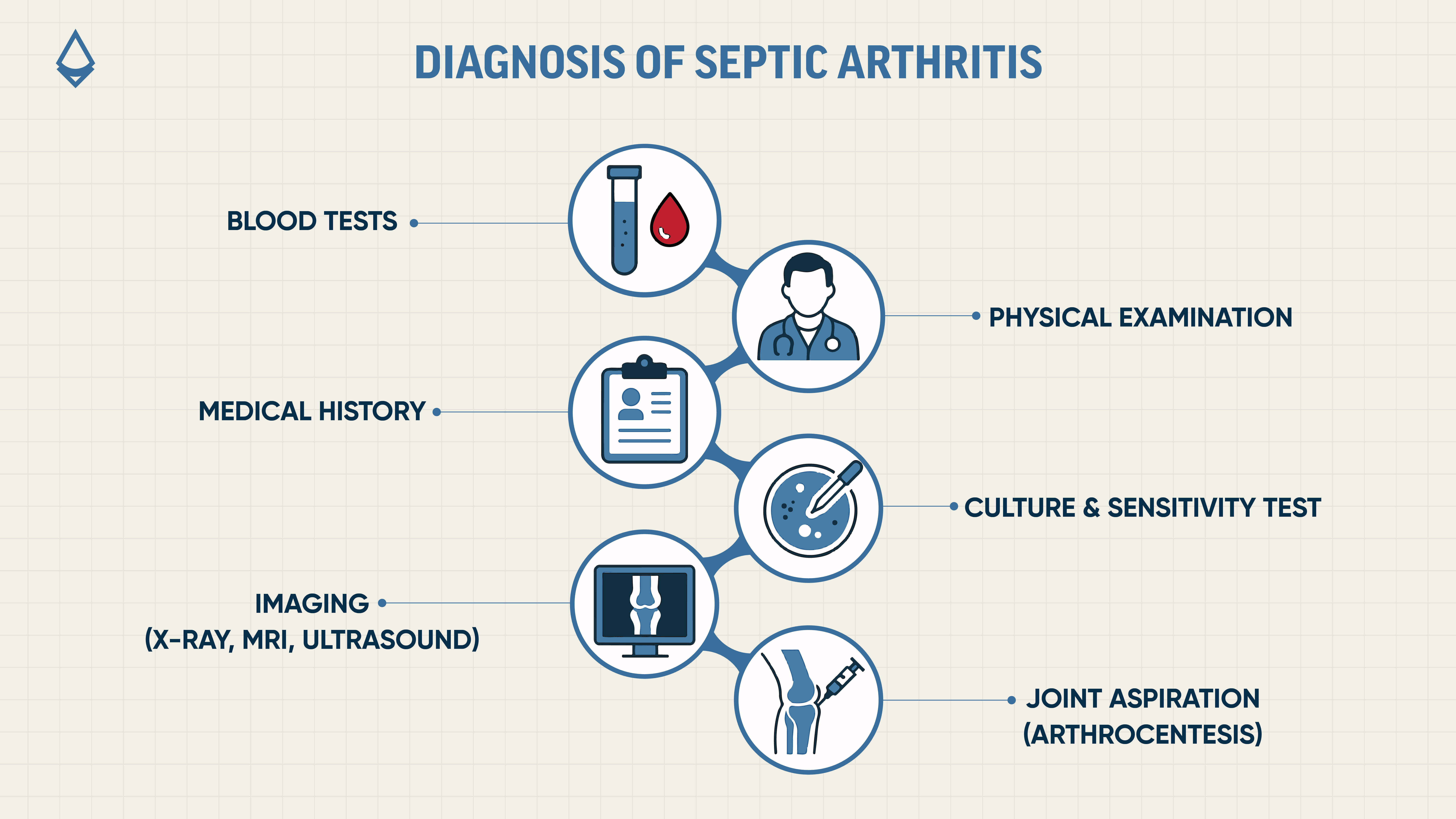What is Septic Arthritis?

Septic arthritis, or infectious arthritis, is a painful condition caused by an infection in a joint. This infection, often bacterial, leads to inflammation that can quickly damage cartilage and bone. While it can affect any joint, the knee is most frequently involved, followed by the hip, shoulder, elbow, and small joints in the hands or feet. The infection usually spreads through the bloodstream but can also enter the joint through direct injury, surgery, or injection.

Who Is at Risk?
Although septic arthritis can affect anyone, certain groups are more vulnerable. Infants and elderly individuals are at greater risk due to weaker immune systems. Those with existing joint conditions like osteoarthritis or rheumatoid arthritis, or chronic diseases such as diabetes, kidney disorders, or HIV, are also more susceptible. Other risk factors include recent joint surgery, injections, skin infections near the joint, or the presence of a prosthetic joint.
What Causes Septic Arthritis?
Septic arthritis can result from a variety of microorganisms, including bacteria, viruses, and fungi. These pathogens can enter the joint through injuries, surgeries, or by spreading from other infected parts of the body.
Common Infectious Agents Include:
Staphylococcus aureus (S. aureus): The most common cause of septic arthritis. This bacterium often lives harmlessly on the skin but can cause serious joint infections when it enters the bloodstream or joint space.
Haemophilus influenzae: A bacterium known to infect the respiratory tract (larynx, trachea, bronchi), more commonly affecting children.
Gram-negative bacilli (e.g., E. coli): These bacteria can cause joint infections, especially in people with compromised immunity or urinary tract infections.
Streptococci: A group of bacteria responsible for various infections that can lead to joint involvement.
Gonococci (Neisseria gonorrhoeae): The bacterium that causes gonorrhea can lead to gonococcal arthritis, especially in sexually active young adults.
Viruses (e.g., HIV, hepatitis viruses): Viral infections can also affect joints, leading to inflammation and symptoms similar to bacterial septic arthritis.
How the Infection Enters the Joint:
Through an open fracture (broken bone piercing the skin).
From an existing infection elsewhere in the body (e.g., skin, urinary tract, or genitals).
Via an infected wound or a foreign object that penetrates the skin.
After joint surgeries or injections, especially if sterility is compromised.
Following an injury that breaks the skin, allowing pathogens direct access.
Signs and Symptoms to Watch For
Septic arthritis develops quickly, often within hours. Key symptoms include intense joint pain that worsens with movement, swelling, redness, warmth, and fever. Patients may also experience fatigue and weakness. In young children, the signs may be more subtle, such as irritability, refusing to walk or move the affected limb, or crying when the joint is touched.
How Is It Diagnosed?
Early diagnosis is crucial to prevent permanent joint damage. The first step is usually joint aspiration (arthrocentesis), where fluid is drawn from the affected joint and tested for signs of infection, such as high white blood cell count or the presence of bacteria. Blood tests are also done to check for elevated inflammatory markers like CRP and ESR, which indicate systemic infection. These help support the diagnosis alongside symptoms.
Imaging techniques like ultrasound and MRI help detect joint swelling, fluid buildup, and early signs of joint damage. While X-rays may not show early infection, they can help assess later complications. The joint fluid is then sent for culture and sensitivity tests to identify the specific microorganism and guide antibiotic treatment. Once the infection is under control, pain relief, anti-inflammatories, and physical therapy help restore joint function and mobility.

Possible Complications
Delays in treatment can lead to serious consequences such as permanent joint damage, chronic pain, osteomyelitis (infection of the bone), or even sepsis. In this potentially life-threatening condition, the infection spreads throughout the body. Children are particularly at risk for long-term complications if the infection occurs near a growth plate, which could affect bone development.
Can It Be Prevented?
Preventing septic arthritis starts with simple but critical practices like maintaining strict hygiene during joint-related procedures, treating skin wounds or infections without delay, and managing chronic conditions that weaken the immune system. High-risk individuals should avoid unnecessary joint injections when possible.
Beyond immediate precautions, long-term joint health can be supported through anti-inflammatory strategies like regular physical therapy, balanced nutrition, and, in certain cases, cannabinoid-based medication. These approaches may reduce chronic inflammation and enhance joint resilience.
With timely diagnosis and appropriate care, septic arthritis is treatable. But any delay can lead to irreversible damage. At the first sign of joint pain with fever or swelling, seeking medical attention is not just advisable, it’s essential.
Read More: